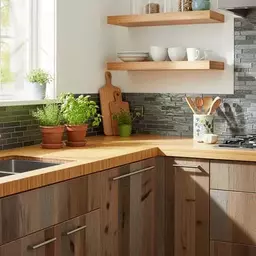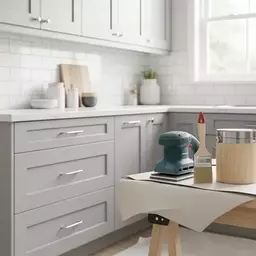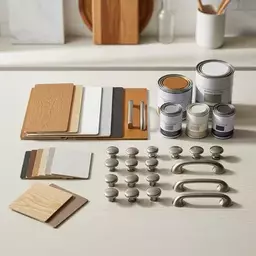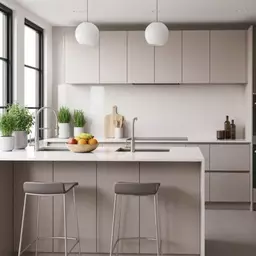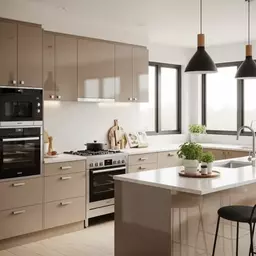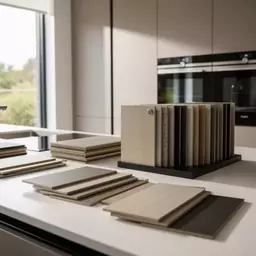Consider this: a kitchen transformation that doesn’t require a complete overhaul, yet delivers a fresh, modern look. Cabinet refacing is a cost-effective solution that allows homeowners to revitalize their space with minimal disruption. Are you ready to explore how this project can elevate the heart of your home?
What You Will Learn
- Cost-Effective Solution: Cabinet refacing is typically less expensive than a full renovation, making it a budget-friendly option for kitchen updates.
- Time-Saving Process: Refacing is quicker and less messy than traditional remodeling, minimizing disruption to your daily life.
- Design Flexibility: Homeowners can customize their cabinets with various styles, colors, and finishes that fit their personal aesthetic.
- Maintenance Essentials: Regular cleaning and checks on hardware can prolong the life of refaced cabinets, keeping them looking new for years.
- DIY vs. Professional Help: Assess your skills and time to determine if a DIY project or hiring a professional is best for your cabinet refacing needs.
- Common Troubleshooting Tips: Learn about typical post-refacing issues, such as peeling finishes or misaligned doors, and how to address them effectively.
- Resources for Further Learning: Engage in workshops or online courses to enhance your cabinet refacing skills and connect with fellow enthusiasts.
Comparing DIY vs Professional Cabinet Refacing
Explore the key differences between tackling cabinet refacing as a DIY project versus hiring a professional, focusing on cost, time, and results. You might also be interested in learning about affordable kitchen refacing in Australia for budget-friendly options.
DIY Refacing
- Cost: More affordable
- Time: Longer process
- Results: Creative freedom, personal touch
Professional Refacing
- Cost: More expensive
- Time: Quicker turnaround
- Results: Polished finish, complex designs
Understanding Cabinet Refacing: A Comprehensive Introduction
Are you tired of your kitchen cabinets looking outdated and worn? Cabinet refacing is a fantastic solution to give your kitchen a fresh and modern feel without breaking the bank. In this section, we'll explore what cabinet refacing is, delve into its benefits, and discuss whether you should tackle this project yourself or hire a professional. Let’s embark on this journey together!
What is Cabinet Refacing and Its Benefits?
Cabinet refacing involves replacing the doors and drawer fronts of your cabinets while keeping the existing structure intact. It's an affordable way to achieve a brand-new look! Here are some key benefits:
- Cost-Effective: It's usually cheaper than a full remodel.
- Less Disruption: The process is quicker and less messy than a complete renovation.
- Sustainability: It reduces waste by reusing existing cabinet boxes.
- Customization: You can choose new styles, colors, and finishes to match your taste.
Imagine stepping into a kitchen that reflects your style without the hefty price tag of a complete renovation! Have you considered how this could change the heart of your home?
DIY vs. Professional Cabinet Refacing: Which is Right for You?
Deciding whether to go the DIY route or hire a professional can be tricky. Both options have their advantages. Here’s a quick comparison to help you choose:
- DIY: More affordable, allows for creativity, offers a rewarding experience.
- Professional: Quick and efficient, ensures a polished finish, ideal for complex designs.
Think about your skills, time, and budget. Have you tackled DIY projects before? If you're confident and enjoy hands-on work, you might find cabinet refacing an exciting challenge. However, if you're short on time or want guaranteed results, hiring a pro could be the way to go! For more detailed DIY techniques, check out our guide on cabinet resurfacing techniques explained.
Popular Design Styles for Cabinet Refacing: Shaker, Raised Panel, and Modern
When it comes to cabinet refacing, style matters! The look of your cabinets can completely transform your kitchen’s vibe. Here are some popular styles to consider:
- Shaker: Simple, clean lines that offer a timeless look.
- Raised Panel: Adds depth and character for a more traditional feel.
- Modern: Sleek and minimalistic designs for a contemporary touch.
Which style resonates with you? Visualizing these options could spark ideas for your kitchen. Think about how each style fits with your overall design vision. Exciting, right?
Quick Summary
Here's a brief recap of the key points discussed so far:
- Cabinet Refacing Overview: A cost-effective way to transform your kitchen by replacing doors and drawer fronts.
- DIY vs. Professional: Weigh the pros and cons of each approach to find what suits your skills and budget.
- Design Styles: Popular options include Shaker, Raised Panel, and Modern, each bringing a unique flair to your kitchen.
- Maintenance Tips: Regular cleaning and care can significantly extend the life of your newly refaced cabinets.
Maintaining Your Newly Refaced Cabinets
Once you've transformed your kitchen with newly refaced cabinets, the next step is ensuring they remain beautiful and functional for years to come. Taking proper care of your cabinets not only enhances their lifespan but also maintains the fresh look you worked so hard to achieve. Have you considered how your daily routine interacts with your cabinets? Let’s dive into some essential maintenance tips!
To keep your cabinets looking their best, a regular cleaning routine is essential. Use a gentle cleaner and a soft cloth to wipe down surfaces, avoiding harsh chemicals that can damage the finish. Additionally, remember to check for any loose hinges or hardware; tightening them can prevent bigger issues down the line. How often do you find yourself neglecting these small details? Let’s explore some easy maintenance tips!
- Wipe cabinets with a soft, damp cloth weekly.
- Use mild soap and water for tougher spots.
- Avoid abrasive cleaners that can scratch the surface.
- Check and tighten hardware regularly.
Post-Refacing Care: Tips for Longevity
After a successful refacing project, it’s crucial to establish a care routine that promotes longevity. Think about your kitchen’s unique environment—humidity, heat, and frequent use can all impact your cabinets. By implementing a few proactive measures, you can keep them in top shape!
One of the best practices is to avoid direct heat sources near your cabinets. If your kitchen is often exposed to high temperatures, consider installing heat shields or rearranging items to prevent contact. Remember that moisture can also be a culprit, so using dehumidifiers in humid areas can be beneficial. Curious about the specific steps? Here are some practical tips! For more details on materials and their care, explore cabinet refacing materials in Australia.
- Keep cabinets away from direct heat sources.
- Use a dehumidifier in damp areas.
- Inspect seals and edges for wear or damage.
- Refresh your cabinet's finish as needed to maintain shine.
Troubleshooting Common Issues After Refacing
Even with the best care, issues can arise after cabinet refacing. It’s part of the journey, and knowing how to troubleshoot these concerns can save you time and effort. Have you experienced any challenges with your refaced cabinets? Let’s look at some common problems and their solutions!
One common issue is peeling or chipping finishes. This can occur if the surface was not prepped correctly or if it’s exposed to too much moisture. If you notice this, don’t panic! Carefully sanding the area and applying a touch-up coat can often solve the problem. Additionally, ensure that your cabinet doors are closing properly—misalignment can lead to unnecessary wear and tear. Here’s a quick list of common issues and how to handle them:
- Peeling Finish: Sand and touch up with the appropriate paint or veneer.
- Misaligned Doors: Adjust hinges or reinstall doors for correct alignment.
- Loose Hardware: Tighten screws or replace hardware as necessary.
- Stains or Marks: Use a gentle cleaner to address spots immediately.
Engaging Your Audience: FAQs About Cabinet Refacing
As I share tips and insights about cabinet refacing, I often hear similar questions from homeowners. It’s exciting to know that so many of you are interested in refreshing your kitchens! If you're facing challenges or have concerns, let’s tackle some of the most frequently asked questions about cabinet refacing together.
Frequently Asked Questions About Cabinet Refacing
Here are some of the most common questions homeowners have about cabinet refacing:
- Q: How long does cabinet refacing typically take?
A: Cabinet refacing is significantly quicker than a full kitchen remodel, often taking only 2-5 days depending on the size of your kitchen and the complexity of the project. - Q: Is cabinet refacing a durable solution?
A: Yes, when done correctly with quality materials, refaced cabinets can last for many years. The durability largely depends on the quality of the new doors, drawer fronts, and veneer, as well as proper installation and maintenance. - Q: Can I change the layout of my kitchen with cabinet refacing?
A: No, cabinet refacing retains your existing cabinet boxes and their layout. If you want to change the kitchen layout, add new cabinets, or move appliances, a full kitchen remodel would be necessary. - Q: What types of materials are used for cabinet refacing?
A: Common materials include laminates (like thermofoil), wood veneers, rigid thermofoil (RTF), and solid wood. Each offers different aesthetics, durability, and price points. - Q: How much does cabinet refacing cost compared to a full replacement?
A: Cabinet refacing is generally 30-50% less expensive than replacing all your cabinets, making it a more budget-friendly option for updating your kitchen's appearance.
Many people wonder about the best maintenance practices post-refacing. Others have concerns about common pitfalls to avoid. It’s essential to address these queries to help empower your DIY journey. Here are some common questions I often encounter:
- How often should I clean my cabinets?
- What should I do if the finish starts to peel?
- Can I add new hardware later on?
- What are the best cleaning products to use?
When to Consider Professional Cabinet Refacing Services
Sometimes, despite your DIY enthusiasm, the time may come when professional help is needed. It’s perfectly okay to seek assistance! Understanding when to call in the experts can save you from unnecessary stress. Have you considered the advantages of hiring professionals for specific tasks?
For larger projects or intricate designs, professional cabinet refacing services can ensure flawless results. If you’re feeling overwhelmed or unsure about your skills, that’s a great indication it might be time to consult an expert. Here’s a quick overview of scenarios where professional help might be beneficial:
- Complex designs that require advanced techniques.
- Limited time to complete the project yourself.
- Uncertainty about the best materials and finishes.
- Health concerns, such as allergies to dust or fumes.
Final Thoughts on Cabinet Refacing
As we wrap up our discussion on cabinet refacing, I hope you feel inspired to take on this rewarding project! Remember, the journey of transforming your kitchen is not only about aesthetics but also about expressing your creativity. Have you thought about the personal touches you might add to your cabinets?
Whether you choose to dive into a DIY project or enlist the help of professionals, the important thing is to enjoy the process and embrace your unique style. And, of course, I’d love to hear about your cabinet refacing journey! Sharing experiences helps us all grow and learn together. What ideas do you have in mind? For more inspiration, check out these stylish kitchen refacing ideas in Australia.
Online Resources and Workshops for Further Learning
For those eager to deepen their knowledge, there are incredible resources available! I recommend checking out local workshops or online courses that focus on cabinet refacing techniques. These can provide valuable insights and hands-on experience. Plus, connecting with other enthusiasts can be so inspiring! Here are some suggestions for where to start:
- Local home improvement stores often host DIY workshops.
- Online platforms like YouTube offer countless tutorials.
- Community forums and blogs can provide support and advice.
- Books on cabinet refacing techniques for in-depth knowledge.
Recap of Key Points
Here is a quick recap of the important points discussed in the article:
- Cabinet Refacing Defined: A cost-effective method to refresh your kitchen by replacing doors and drawer fronts while keeping the existing cabinet structure.
- Benefits of Refacing: Includes affordability, less disruption, sustainability, and customization options.
- DIY vs. Professional: Weigh your skills and time; DIY offers creativity and cost savings, while professionals ensure a polished finish.
- Popular Styles: Consider Shaker, Raised Panel, and Modern styles to match your kitchen's aesthetic.
- Maintenance Tips: Regular cleaning, avoiding harsh chemicals, and checking hardware are essential for longevity.
- Troubleshooting: Address common issues like peeling finishes, misaligned doors, and loose hardware promptly to maintain your cabinets.
- Professional Help: Seek expert assistance for complex designs, time constraints, or if you have health concerns.


